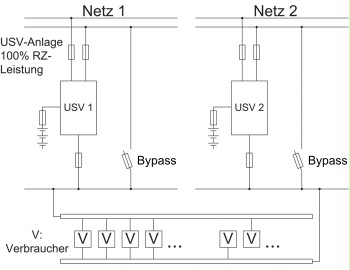S 1.3 Appropriate segmentation of circuits
Initiation responsibility: Building Services Manager
Implementation responsibility: Building Services
Experience has shown that the room allocation and power ratings used to design an electric installation will eventually no longer meet the actual needs. It is therefore essential to review and, where appropriate, modify the electric installation in rooms when they are to be used for a different purpose or when changes and modifications are made to technical equipment (IT, air-conditioning system, lighting, etc.). In the case of minor modifications, this can be done by rewiring the installation. However, it may sometimes be necessary to install additional or completely new power feeds, power cables, distributors, etc.
Both with a view to security and in view of the increasingly rapid data connections via copper cables it is highly recommended that the electrical distribution network is designed as a TN-S network in the whole building. This is also required by DIN VDE 0100-444. In this case, the PE and N conductors are routed separately after the potential equalisation bar (PEB). It is generally not necessary to take individual measures on IT devices in this case any more. However, note the information in section S 1.28 Local uninterruptible power supply about the formation of a new TN-S network for the connected devices.
To ensure and maintain the effectiveness of the TN-S network design, it must be ensured that the only connection between the PE and N conductors in the entire network is on the PEB (ground). In actual practice, though, accidental creation of another connection between the PE and N conductors when a new device is connected or when working on the network cables cannot be ruled out. For this reason, changes to the data network should always be coordinated with Building Services. Furthermore, a TN-S network should be checked at regular intervals for proper grounding. This can be done whenever performing the inspections of the power supply network required anyway and when problems are suspected (for example if intermittent disruptions in the data network occur over a longer period of time). Ideally, a TN-S network is equipped with a differential current monitor.
When high or very high requirements are placed on the availability of the IT, the IT devices are usually supplied with electrical power by two separate and independent electrical power systems, and the IT devices used in this case are equipped with two power supplies.
The most important equipment (storage components, central network nodes, important servers) is connected to both of the independent power networks, "Network 1" and "Network 2", at the same time (see the figure below). Other IT components with lower requirements are then distributed equally between the two supply networks.

Figure: Secure supply of power using two power networks
For the devices connected to only one network, special care must be taken to ensure that the redundant devices are not connected to the same power network as the original device. In addition, the devices must be distributed equally in terms of their power consumption between the two networks.
Review questions:
- Are the protection circuits and the circuit designs reviewed regularly to ensure they actually meet the current requirements?
- For high availability: Are the IT devices supplied by two separate and independent electrical power systems?

